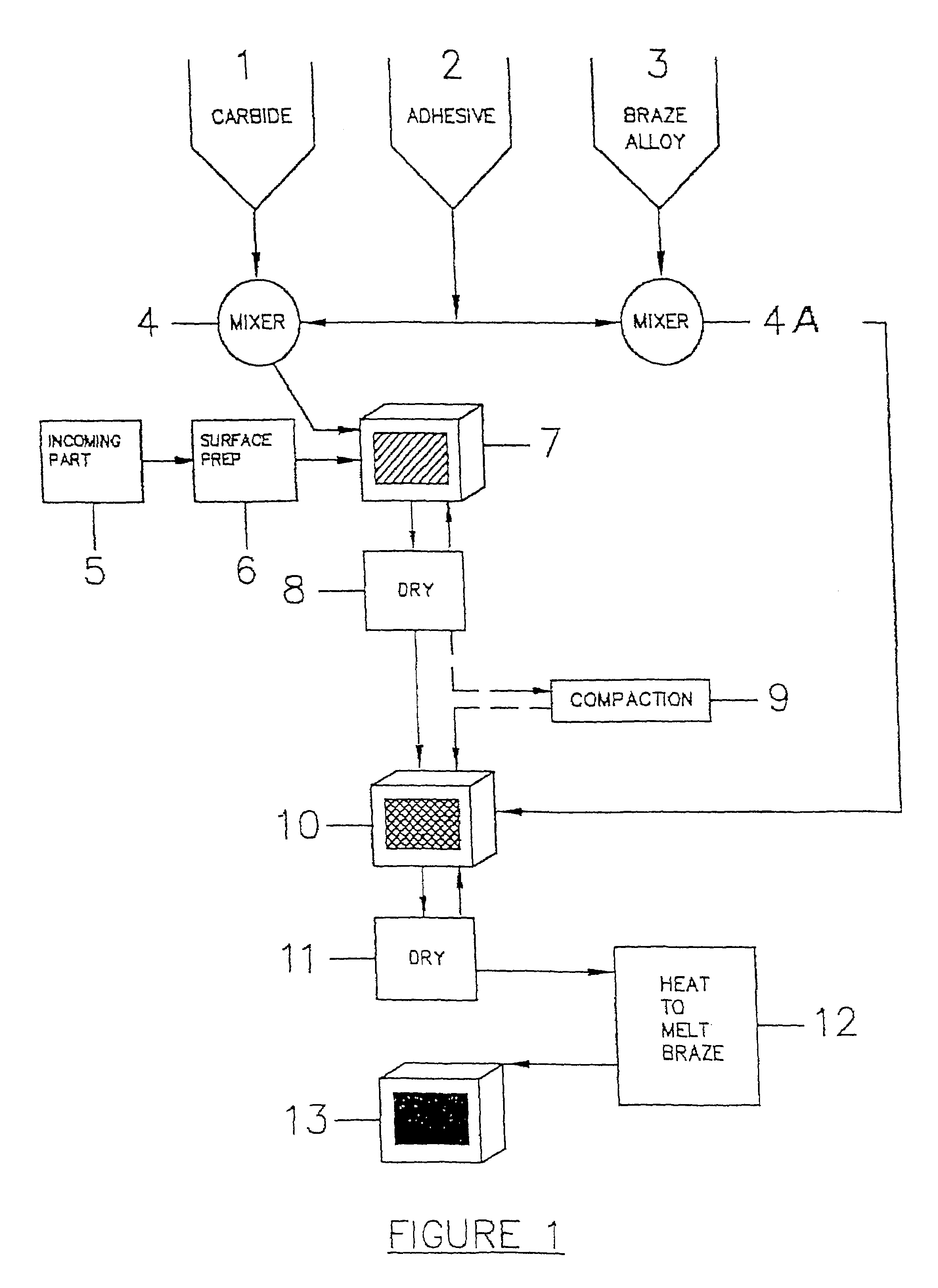Process for making wear-resistant coatings
a technology of coating and hardfacing particles, applied in applications, electrochemical generators, greenhouse cultivation, etc., can solve the problems of hampered infiltration process of hardfacing particles and braze particles for carbide-containing coatings
- Summary
- Abstract
- Description
- Claims
- Application Information
AI Technical Summary
Benefits of technology
Problems solved by technology
Method used
Image
Examples
example 1
[0082]This is an example of applying a layer of tungsten carbide by means of a paint and then applying a layer of braze by sprinkling the braze particles onto an adhesive layer over the paint. A type 316 stainless shield used to protect fans was coated by the following procedure. The fans being protected were those moving flue gases in coal-fired power plants. The shields were 1346 millimeters (mm) long and bent to fit over the leading edge of a fan blade. A paint was made by first mixing 3340 milliliters (ml) of water with 500 ml of Acrysol ASE-60 manufactured by Rohm & Haas. Five-percent by weight ammonium hydroxide solution in water was slowly stirred into this mixture to increase the viscosity. Then, 9 kilograms of tungsten carbide that had a particle size distribution from two to ten microns was blended into the water thickened with the ASE-60. This was blended with a high shear mixer for ten minutes to break up clusters of tungsten carbide. The viscosity of the paint thus form...
example 2
[0086]This is an example of using an alternative embodiment of the invention, in which the wet adhesive is applied to the substrate and then hard particle powder is applied to the adhesive. Both a layer of hard particles and a layer of braze particles were applied in this manner. A coupon of type 4140 steel 25.4 mm×63.5 mm was coated in the following manner: An adhesive was made by mixing 1550 ml of water with 8 ml solution of SAG 10 antifoaming agent (made by WITCO Corporation), 360 ml of ASE-60 acrylate thickening agent, and 24 ml propylene glycol plasticizer. Sixty ml of a solution of 5% by weight ammonium hydroxide in water was slowly stirred into this mixture. The viscosity as measured with the Brookfield viscometer using a #3 spindle at 20 rpm was 750 centipoises.
[0087]The steel coupon was sprayed with the adhesive to a film thickness of approximately 0.05 mm. An air spraying system made by Spraying Systems, Inc. was used. The coupon was immediately submerged in a fluidized be...
example 3
[0092]This is another example of applying layers of adhesive and dry particles. In this case, the particles are applied by means of dry spraying. A coupon of type 4140 steel 25.4 mm×76.2 mm×63.5 mm was coated in the following manner: An adhesive was made by mixing 1550 ml of water with 8 ml solution of SAG 10 antifoaming agent (made by WITCO Corporation), 360 ml of ASE-60 acrylate thickening agent, and 24 ml propylene glycol plasticizer. Sixty ml of a solution of 5% by weight ammonium hydroxide in water was slowly into this mixture. The viscosity as measured with the Brookfield viscometer using a #3 spindle at 20 rpm was 750 centipoises.
[0093]The steel coupon was sprayed with the adhesive to a film thickness of approximately 0.05 mm. An air spraying system made by Spraying Systems, Inc. was used. The coupon was immediately sprayed with a dry powder of tungsten carbide with a particle size range of 10 to 44 microns. The carbide had been prepared by crushing tungsten carbide bonded wi...
PUM
| Property | Measurement | Unit |
|---|---|---|
| Viscosity | aaaaa | aaaaa |
| Percent by volume | aaaaa | aaaaa |
| Acidity | aaaaa | aaaaa |
Abstract
Description
Claims
Application Information
 Login to View More
Login to View More - R&D
- Intellectual Property
- Life Sciences
- Materials
- Tech Scout
- Unparalleled Data Quality
- Higher Quality Content
- 60% Fewer Hallucinations
Browse by: Latest US Patents, China's latest patents, Technical Efficacy Thesaurus, Application Domain, Technology Topic, Popular Technical Reports.
© 2025 PatSnap. All rights reserved.Legal|Privacy policy|Modern Slavery Act Transparency Statement|Sitemap|About US| Contact US: help@patsnap.com

